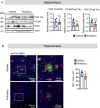Probiotic Bifidobacterium breve Prevents Memory Impairment Through the Reduction of Both Amyloid-β Production and Microglia Activation in APP Knock-In Mouse
- PMID: 34958017
- PMCID: PMC8925106
- DOI: 10.3233/JAD-215025
Probiotic Bifidobacterium breve Prevents Memory Impairment Through the Reduction of Both Amyloid-β Production and Microglia Activation in APP Knock-In Mouse
Erratum in
-
Erratum to: Probiotic Bifidobacterium breve Prevents Memory Impairment Through the Reduction of Both Amyloid- Production and Microglia Activation in APP Knock-In Mouse.J Alzheimers Dis. 2023;92(2):725. doi: 10.3233/JAD-229022. J Alzheimers Dis. 2023. PMID: 36911953 Free PMC article. No abstract available.
Abstract
Background: Probiotic supplementation reestablishes microbiome diversity and improves brain function in Alzheimer's disease (AD); their molecular mechanisms, however, have not yet been fully illustrated.
Objective: We investigated the effects of orally supplemented Bifidobacterium breve MCC1274 on cognitive function and AD-like pathologies in AppNL-G-F mice.
Methods: Three-month-old AppNL-G-F mice were orally supplemented with B. breve MCC1274 for four months. The short-term memory function was evaluated using a novel object recognition test. Amyloid plaques, amyloid-β (Aβ) levels, Aβ fibril, amyloid-β protein precursor and its processing enzymes, its metabolic products, glial activity, and cell proliferation in the subgranular zone of the dentate gyrus were evaluated by immunohistochemistry, Aβ ELISA, western blotting, and immunofluorescence staining. The mRNA expression levels of pro- and anti-inflammatory cytokines were determined by qRT-PCR analysis.
Results: We found that the oral B. breve MCC1 274 supplementation prevented memory impairment in AppNL-G-F mice and decreased hippocampal Aβ levels through the enhancement of the a-disintegrin and metalloproteinase 10 (ADAM10) level. Moreover, administration of the probiotic activated the ERK/HIF-1α signaling pathway responsible for increasing the ADAM10 level and also attenuated microglial activation, which in turn led to reduction in the mRNA expression levels of pro-inflammatory cytokines in the brain. In addition, B. breve MCC1274 supplementation increased the level of synaptic proteins in the hippocampus.
Conclusion: Our findings support the possibility that oral B. breve MCC1274 supplementation might be used as a potential preventive therapy for AD progression.
Keywords: ADAM10; Alzheimer’s disease; Bifidobacterium breve MCC1274; ERK; HIF-1α; amyloid-β production; glial activation; novel object recognition; synapses.
Conflict of interest statement
Authors’ disclosures available online (
Figures






References
-
- Mount C, Downton C (2006) Alzheimer disease: progress or profit? Nat Med 12, 780–784. - PubMed
-
- Takasugi N, Tomita T, Hayashi I, Tsuruoka M, Niimura M, Takahashi Y, Thinakaran G, Iwatsubo T (2003) The role of presenilin cofactors in the gamma-secretase complex. Nature 422, 438–441. - PubMed
-
- Castro-Gomez S, Binder J, Heneka MT (2019) [Neuroinflammation as motor of Alzheimer’s disease]. Nervenarzt 90, 898–906. - PubMed
-
- Heneka MT, Carson MJ, El Khoury J, Landreth GE, Brosseron F, Feinstein DL, Jacobs AH, Wyss-Coray T, Vitorica J, Ransohoff RM, Herrup K, Frautschy SA, Finsen B, Brown GC, Verkhratsky A, Yamanaka K, Koistinaho J, Latz E, Halle A, Petzold GC, Town T, Morgan D, Shinohara ML, Perry VH, Holmes C, Bazan NG, Brooks DJ, Hunot S, Joseph B, Deigendesch N, Garaschuk O, Boddeke E, Dinarello CA, Breitner JC, Cole GM, Golenbock DT, Kummer MP (2015) Neuroinflammation in Alzheimer’s disease. Lancet Neurol 14, 388–405. - PMC - PubMed
Publication types
MeSH terms
Substances
LinkOut - more resources
Full Text Sources
Medical
Molecular Biology Databases
Research Materials
Miscellaneous

